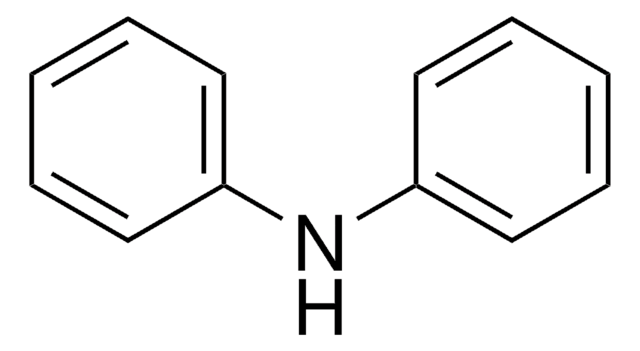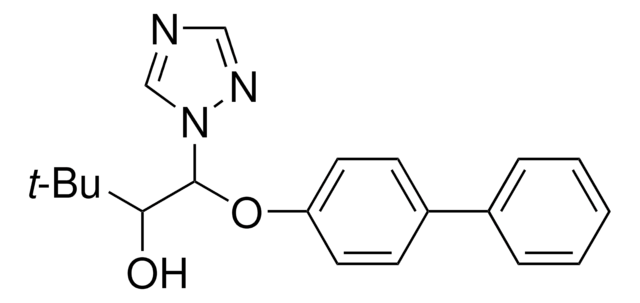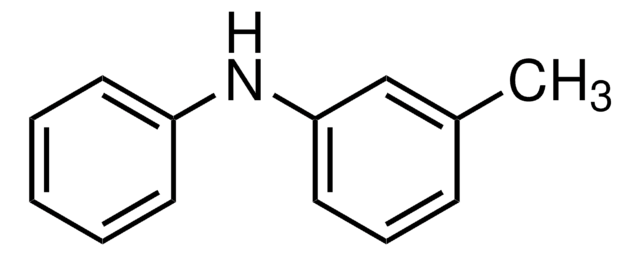Kluczowe dokumenty
CRM69121
Diphenylamine
certified reference material, TraceCERT®, Manufactured by: Sigma-Aldrich Production GmbH, Switzerland
About This Item
Polecane produkty
klasa czystości
certified reference material
TraceCERT®
Poziom jakości
gęstość pary
5.82 (vs air)
ciśnienie pary
1 mmHg ( 108 °C)
linia produktu
TraceCERT®
temp. samozapłonu
1175 °F
okres trwałości
limited shelf life, expiry date on the label
producent / nazwa handlowa
Manufactured by: Sigma-Aldrich Production GmbH, Switzerland
tw
302 °C (lit.)
mp
50-53 °C (lit.)
format
neat
ciąg SMILES
N(c1ccccc1)c2ccccc2
InChI
1S/C12H11N/c1-3-7-11(8-4-1)13-12-9-5-2-6-10-12/h1-10,13H
Klucz InChI
DMBHHRLKUKUOEG-UHFFFAOYSA-N
Szukasz podobnych produktów? Odwiedź Przewodnik dotyczący porównywania produktów
Opis ogólny
Certified content by quantitative NMR incl. uncertainty and expiry date are given on the certificate.
Download your certificate at: http://www.sigma-aldrich.com
Diphenylamine is a fat-soluble organic antioxidant, widely used to control post-harvest skin scalding in apples and pears by preventing the oxidation of α-farnesene.
According to the Commission Implementing Regulation (EU) No 578/2012 of 29th June 2012, diphenylamine is not approved for use in the European Union (EU) as an active substance in the plant protection products, following the Regulation (EC) No. 1107/2009. But a default maximum residue limit of 0.05 mg/kg is allowed for its presence in the products of plant and animal origin as per the EU Reg. 2018/1515.
Zastosowanie
Diphenylamine CRM may also be used as given below:
- Development and validation of a gas chromatography-mass spectrometry (GC-MS) method for the simultaneous analysis of diphenylamine, tolylfluanid, propargite, and phosalone in human liver samples
- Determination of diphenylamine residues in fruit samples after applying a combination of supercritical fluid extraction (SFE) and supramolecular solvent-based microextraction (SSME) for the extraction, followed by a determination using high-performance liquid chromatography (HPLC) with ultraviolet (UV) detection
- Evaluate a newly designed molecularly imprinted polymer (MIP) based on β-cyclodextrin (β -CD) and graphene oxide (GO) for the determination of diphenylamine
- Analysis of diphenylamine in apple samples using an electrochemical sensor based on phosphomolybdic acid (PMo12) and graphene oxide (GO)
- Investigate the performance of an electrochemical sensor founded upon polymeric carbon-rich graphitic carbon nitride (C-gCN) to detect diphenylamine in apple juice samples
- Study the determination of diphenylamine in apple and pear samples using an electrochemical sensor based on Copper@nanoporous carbon (Cu@NPC) as the electrode material
Inne uwagi
The collision cross section (CCS) measurement was provided by Waters Corporation, using the SYNAPT XS mass spectrometer.
For a description and overview of how ion mobility enables the measurement of the CCS of an ion visit ims.waters.com.
Further information on the SYNAPT XS mass spectrometer can be found on the IMS microsite and product webpage.
TWCCS measurements are expected to be within 2% of this reference value.
P/N CRM69121 is part of the Waters Extractables & Leachables UNIFI scientific library which can be downloaded from Waters Marketplace.
Polecane produkty
Informacje prawne
Hasło ostrzegawcze
Danger
Zwroty wskazujące rodzaj zagrożenia
Zwroty wskazujące środki ostrożności
Klasyfikacja zagrożeń
Acute Tox. 3 Dermal - Acute Tox. 3 Inhalation - Acute Tox. 3 Oral - Aquatic Acute 1 - Aquatic Chronic 1 - STOT RE 2
Organy docelowe
Kidney,Liver,spleen
Kod klasy składowania
6.1C - Combustible acute toxic Cat.3 / toxic compounds or compounds which causing chronic effects
Klasa zagrożenia wodnego (WGK)
WGK 3
Wybierz jedną z najnowszych wersji:
Certyfikaty analizy (CoA)
Nie widzisz odpowiedniej wersji?
Jeśli potrzebujesz konkretnej wersji, możesz wyszukać konkretny certyfikat według numeru partii lub serii.
Masz już ten produkt?
Dokumenty związane z niedawno zakupionymi produktami zostały zamieszczone w Bibliotece dokumentów.
Nasz zespół naukowców ma doświadczenie we wszystkich obszarach badań, w tym w naukach przyrodniczych, materiałoznawstwie, syntezie chemicznej, chromatografii, analityce i wielu innych dziedzinach.
Skontaktuj się z zespołem ds. pomocy technicznej







